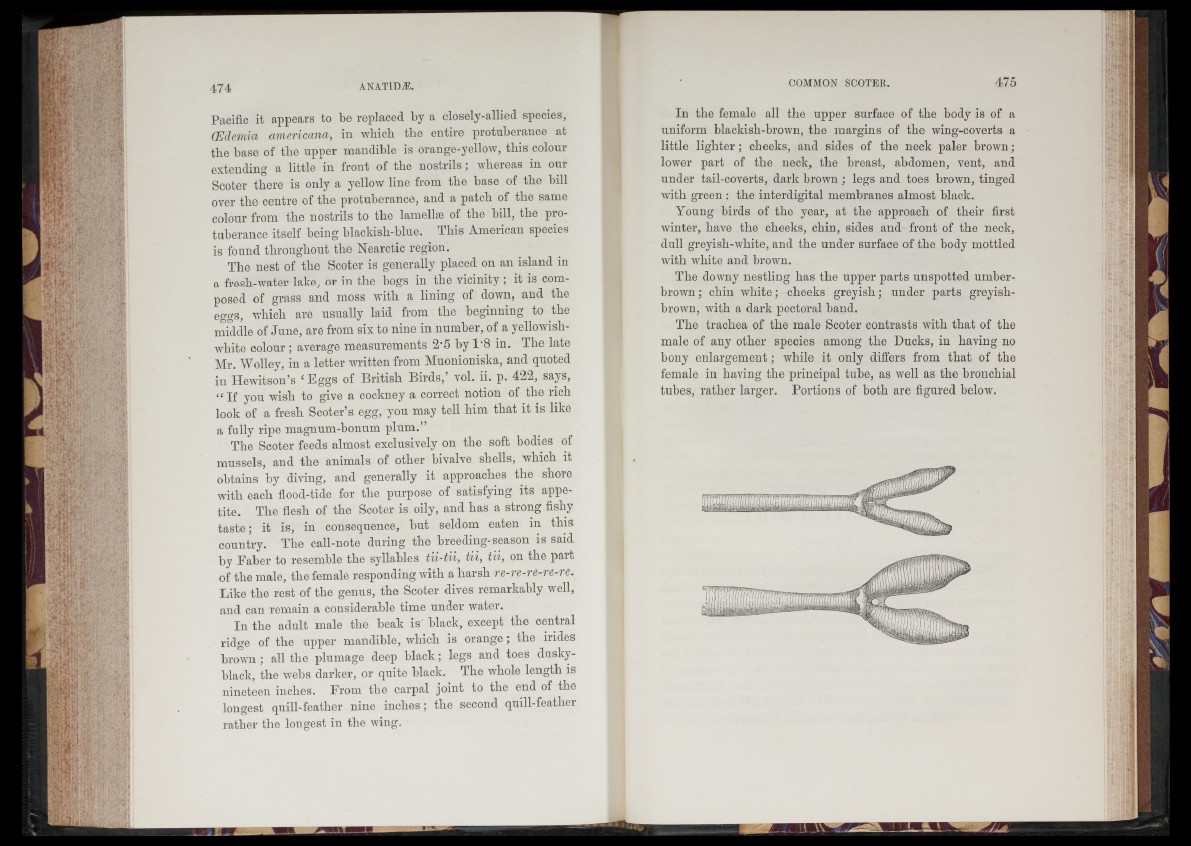
Pacific it appears to be replaced by a closely-allied species,
CEdemia americana, in which the entire protuberance at
the base of the upper mandible is orange-yellow, this colour
extending a little in front of the nostrils, whereas in oui
Scoter there is only a yellow line from the base of the bill
over the centre of the protuberance, and a patch of the same
colour from the nostrils to the lamellae of the bill, the pio-
tuberance itself being blackish-blue. This American species
is found throughout the Nearctic region.
The nest of the Scoter is generally placed on an island in
a fresh-water lake, or in the bogs in the vicinity ; it is composed
of grass and moss with a lining of down, and the
eggs, which are usually laid from the beginning to the
middle of June, are from six to nine in number, of a yellowish-
white colour; average measurements 2*5 by 1-8 in. The late
Mr. Wolley, in a letter written from Muonioniska, and quoted
in Hewitson’s ‘ Eggs of British Birds, vol. ii. p. 422, says,
you wish to give a cockney a correct notion of the rich
look of a fresh Scoter’s egg, you may tell him that it is like
a fully ripe magnum-bonum plum.”
The Scoter feeds almost exclusively on the soft bodies of
mussels, and the animals of other bivalve shells, which it
obtains by diving, and generally it approaches the shoie
with each flood-tide for the purpose of satisfying its appetite.
The flesh of the Scoter is oily, and has a strong fishy
taste; it is, in consequence, but seldom eaten in this
country. The call-note during the breeding-season is said
by Faber to resemble the syllables tii-tii, tii, tii, on the part
of the male, the female responding with a harsh re-re-re-re-re.
Like the rest of the genus, the Scoter dives remarkably well,
and can remain a considerable time under water.
In the adult male the beak is' black, except the central
ridge of the upper mandible, which is orange; the irides
brown ; all the plumage deep black; legs and toes dusky-
black, the wTebs darker, or quite black. The whole length is
nineteen inches. From the carpal joint to the end of the
longest quill-feather nine inches; the second quill-feather
rather the longest in the wing.
In the female all the upper surface of the body is of a
uniform blackish-brown, the margins of the wing-coverts a
little lighter; cheeks, and sides of the neck paler brown ;
lower part of the neck, the breast, abdomen, vent, and
under tail-coverts, dark brown ; legs and toes brown, tinged
with green : the interdigital membranes almost black.
Young birds of the year, at the approach of their first
winter, have the cheeks, chin, sides and front of the neck,
dull greyish-white, and the under surface of the body mottled
with white and brown.
The downy nestling has the upper parts unspotted umber-
brown ; chin white; cheeks greyish; under parts greyish-
brown, with a dark pectoral band.
The trachea of the male Scoter contrasts with that of the
male of any other species among the Ducks, in having no
bony enlargement; while it only differs from that of the
female in having the principal tube, as well as the bronchial
tubes, rather larger. Portions of both are figured below.